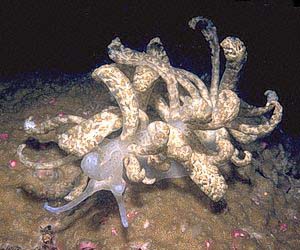
Phyllodesmium longicirrum
(Bergh, 1905)
Order: NUDIBRANCHIA
Suborder: AEOLIDINA
Family: Glaucidae
DISTRIBUTION
Known from the Indonesian Archipelago to the Great Barrier Reef, Australia.
PHOTO
RIGHT: Animal (10cm long) crawling over Porites colony. Indonesia.
LOWER LEFT: Ceras showing the white ducts of the digestive gland radiating out to the brown "gardens" of symbiotic zooxanthellae. PHOTO: Bill Rudman.
LOWER RIGHT: Section through the a ceras showing the ducts leading to the zooxanthellae "gardens" at the surface of the ceras. (zooxanthellae stained red.) PHOTO: Bill Rudman.
RELATED TOPIC
Phyllodesmium longicirrum is probably the most spectacular of the aeolids which have evolved a symbiotic relationship with single-celled plants (zooxanthellae). It is exceptionally large, often more than 12cm long, and the cerata have evolved into large flattened "solar paddles" to maximise the animal's ability to "farm' the plants in its body. It is known to feed on the soft-coral Sarcophyton, but we don't know if it eats other soft corals. It obviously has a symbiotic relationship with zooxanthellae [see Solar-powered Sea Slug Page] but we can only guess that it gets the zooxanthellae from Sarcophyton. Like all species of Phyllodesmium, this species lacks the defensive cnidosacs usually found in aeolids. Coll et al (1985) have shown that it stores the diterpene trocheliophorol in its cerata. This distasteful, if not toxic, chemical is obtained from it food, the soft coral Sarcophyton trocheliophorium and is possibly an alternative way to ptotect it from predators.
References:
• Coll, J.C., Bowden, B.F., Tapiolas, D.M., Willis, R.H., Djura, P.. Streamer, M. & Trott, L. (1985) Studies of Australian soft corals - XXXV. The terpenoid chemistry of soft corals and its implications. Tetrahedron, 41(6): 1085-1092.
• Rudman, W.B. (1981) The anatomy and biology of alcyonarian feeding aeolid opisthobranch molluscs and their development of symbiosis with zooxanthellae. Zoological Journal of the Linnean Society, 72: 219-262.
• Rudman, W.B. (1991) Further studies on the taxonomy and biology of the octocoral-feeding genus Phyllodesmium Ehrenberg, 1831 (Nudibranchia: Aeolidoidea). Journal of Molluscan Studies, 57(2): 167-203.


Rudman, W.B., 1998 (October 11) Phyllodesmium longicirrum (Bergh, 1905). [In] Sea Slug Forum. Australian Museum, Sydney. Available from http://www.seaslugforum.net/find/phyllong
Related messages
Re: Phyllodesmium longicirrum feeding
December 8, 2006
From: Michael Henke
Concerning message #18948:
Dear Bill,
Thanks again for your comments. I also wish I had given it a gentle poke and taken a few macro pictures, but my real problem while taking the photos was to find the head of the nudi. Even looking at the pictures, I hadn't seen the contracted oral tentacles until you showed them to me. Thanks! I have more pictures of this nudi, but on looking at them I can't find an answer to our questions. Maybe you have a better eye and if you'd like to look, I can send them to you.
Best wishes,
Michael
henke@seddoc.de
Henke, M., 2006 (Dec 8) Re: Phyllodesmium longicirrum feeding. [Message in] Sea Slug Forum. Australian Museum, Sydney. Available from http://www.seaslugforum.net/find/18964Thanks Mike,
I think we have to consider this unanswerable. I have put your Phyllodesmium on the Forum's 'abnormalities ' page. Most records there seem to be developmental abnormalities, but some, like yours, seem to be the result of damage and faulty regrowth.
Best wishes,
Bill Rudman
Re: Phyllodesmium longicirrum feeding
December 6, 2006
From: Michael Henke
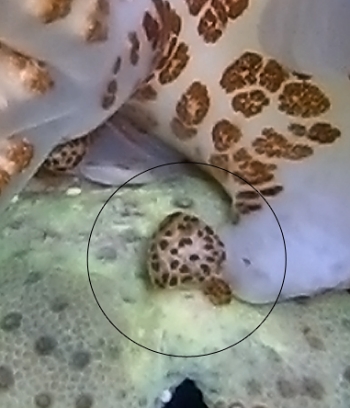
Concerning message #18808:
Dear Bill,
Thanks for your comments. What I especially wanted to know is what is the little round part of the Phyllodesmium longicirrum. It doesn't look like feeding. Maybe it's an egg?
Best wishes,
Michael
Henke@mededv.de
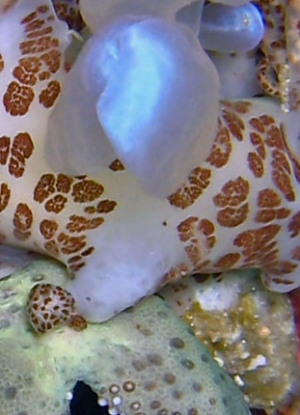
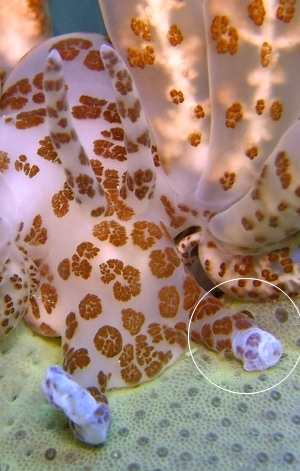
Dear Michael,
As well as your close-up, I've added a couple of close-ups as well from your earlier photos. I ma pretty sure the round thing is attached to the white bit. I at first thought this was part of the reproductive system but it's in the wrong place. I am pretty sure its part of the same phenomenon that has caused the white cerata. It seems to be some aberrant regrowth after some injury. I'm sorry I can't be more specific but if I had the animal in front of me I could give it a gentle poke and prod just to get a better idea of what this structure is. All I can say is that it is abnormal and definitely isn't anything to do with feeding. You can see the head in the bottom right photo. I have ringed one of the oral tentacles. I am not quite sure why the oral tentacles are so contracted - perhaps they are sensitive to some defensive chemical the soft coral is exuding?
Best wishes,
Bill Rudman
Phyllodesmium longicirrum feeding
December 6, 2006
From: Michael Henke
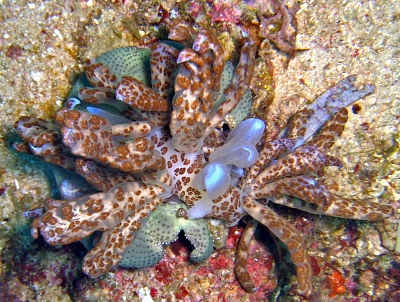
Concerning message #11902:
Dear Bill,
What is the Phyllodesmium longicirrum doing here and why are some parts of the ducts totally white? Hope you enjoy the pictures.
Locality: Batu Tiga, 15 m, Nord Sulawesi, Indo Pacific, 2 November 2006, soft coral. Length: 20 cm. Photographer: Michael Henke.
Thanks for your time,
Michael
henke@seddoc.de

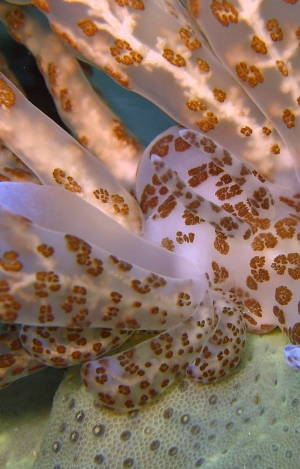
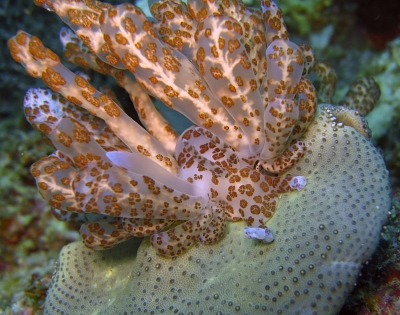
Dear Mike,
I guess you have looked at the solar powered sea slug page, and the related topics listed there. Phyllodesmium longicirrum is one of the most spectacular of the solar-powered slugs because of its large flattened cerata, which remind me of the large solar paddles on earth-orbiting satellites. In this species the brown rings you can see on the skin of the body, the rhinophores and the cerata, are gardens of single-celled plants [zooxanthellae] which the animal obtains from the soft coral Sarcophyton, on which it is feeding in your photos. The pale whitish branching in the cerata are the ducts of the gut which take the zooxanthellae from the stomach out to these gardens. I am not sure why a few of the cerata are colourless but its seems they lack both the ducts of the gut and the zooxanthellae. P. longicirrum, like all species ofPhyllodesmium, is able to cast off its cerata [autotomy], much like some lizards drop off their tail, as a defensive strategy. They are able to regrow these cerata quite quickly. Perhaps these are some replacement cerata which for some reason were unable to regrow the branches of the gut?
Best wishes,
Bill Rudman
Phyllodesmium longicirrum on Sarcophyton
January 15, 2004
From: Mary Jane Adams
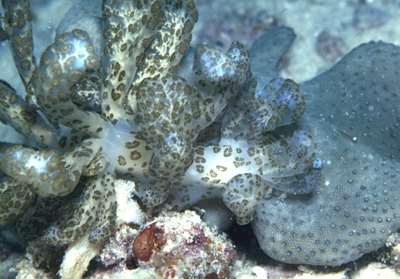

Hi Bill,
I photographed this Phyllodesmium longicirrum at Kapalai Island, east of Sabah, Malaysian Borneo, on Nov. 26, 2003. It was about 12 cm long and about 10 meters deep. It appeared to be grazing on a Sarcophyton sp leather coral. In the upper image I noticed that the brown patches of zooxanthellae occur not only at the terminal branches of the digestive gland in the cerata, but also on the
notum, oral tentacles and even on the rhinophores. How do you interpret this finding?
Best regards,
Mary Jane
divepng@yahoo.com
Adams, M.J., 2004 (Jan 15) Phyllodesmium longicirrum on Sarcophyton. [Message in] Sea Slug Forum. Australian Museum, Sydney. Available from http://www.seaslugforum.net/find/11902Thanks Mary Jane,
Many of the Solar powered sea slugs have branches of the gut forming a network of ducts throughout the body wall. In sacoglossans which store chloroplasts from their algal food branching digestive gland ducts are found in both the slugs which keep chloroplasts alive and slugs that don't. I suspect the branching developed initially as a way fro the animal to camouflage itself when in its food.
In the nudibranchs, such as Phyllodesmium, which keep zooxanthellae alive, branches of the gut in the body wall is a new development and only found in those with the zooxanthellae symbiosis. In these species all parts of the body which are not shaded from sunlight have branches of the digestive gland just beneath the skin. Clearly this is a way of maximising the use of available space for photosynthesis - just like plants arrange their leaves
Best wishes
Bill Rudman
Phyllodesmium longicirrum - Lembeh Straits [2]
October 14, 2003
From: Rich
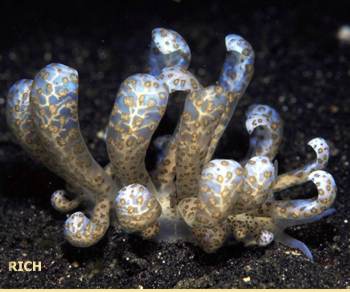
Dr Bill,
Wondered if you would like this photo of Phyllodesmium longicirrum (I think).
Photo taken at Lembeh Straights, Retak Larry, Indonesia at about 18m, September 2003.
The site is on the side of the straits that has the black volcanic sand.
Cheers
Rich
TheHamburger@damnam.org
Rich, 2003 (Oct 14) Phyllodesmium longicirrum - Lembeh Straits [2]. [Message in] Sea Slug Forum. Australian Museum, Sydney. Available from http://www.seaslugforum.net/find/11052Thanks Rich,
Yes this is Phyllodesmium longicirrum. This is the epitome of the Solar Powered nudibranch. The brown patches on the flattened leaf-like cerata are little gardens of one-celled plants - zooxanthellae - and the whitish brown branches are ducts of the digestive gland that allow the zooxanthellae to get from the stomach to the 'gardens'.
Best wishes
Bill Rudman
Phyllodesmium longicirrum - Lembeh Straits
October 14, 2003
From: Paul Whitehead
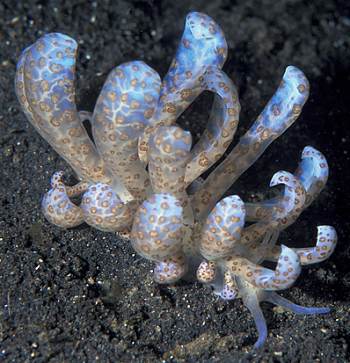
Dear Dr. Rudman,
This Phyllodesmium longicirrum was at seen at Lembeh Strait (Sulawesi, Indonesia) in September. It was one of a pair seen moving across black sand at about 15 meters, it was approx 15-20 cm in length
Paul
Whitehead@damnam.org
Whitehead, P., 2003 (Oct 14) Phyllodesmium longicirrum - Lembeh Straits. [Message in] Sea Slug Forum. Australian Museum, Sydney. Available from http://www.seaslugforum.net/find/11180Thanks Paul,
I guess this is probably the same pair as in Rich's message. They are a spectacular sight - and i guess even more so when they are crawling over black sand
Bestw wishes
Bill Rudman
Phyllodesmium longicirrum from Sulawesi
December 18, 2002
From: Mary Jane Adams

Hi Bill,
The dive guides in Lembeh Strait, Sulawesi Island, Indonesia, regularly find Phyllodesmium longicirrum under or on top of leather corals at Angel's Window. This divesite is a coral reef slope on the Lembeh Island side of the strait. There is a large patch of leather coral between seven and fifteen meters where they feed. I photographed this one at about 7 meters on Nov. 18, 2002. It is about 15cm long and about 10cm tall.
Best regards,
Mary Jane
divepng@yahoo.com
Adams, MJ., 2002 (Dec 18) Phyllodesmium longicirrum from Sulawesi. [Message in] Sea Slug Forum. Australian Museum, Sydney. Available from http://www.seaslugforum.net/find/8661Thanks Mary Jane,
Its sounds an ideal place for someone to do some work on the biology of these fascinating animals. Just how much of their nutrient requirements are met by the gardens of zooxanthellae scattered through their bodies?
Best wishes,
Bill Rudman
Juvenile Phyllodesmium longicirra
May 10, 2002
From: Mary Jane Adams
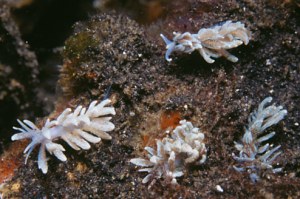
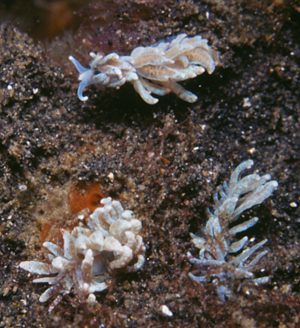
Hi Bill,
I found this group of aeolids on a silty sand slope with patches of low reef. They are about 8 mm long. I think they are juvenile Phyllodesmium longicirra. What do you think?
Divesite: Hairball, Lembeh Strait, Sulawesi, Indonesia, April 19, 2002
Best regards,
Mary Jane
divepng@yahoo.com
Adams, M J., 2002 (May 10) Juvenile Phyllodesmium longicirra. [Message in] Sea Slug Forum. Australian Museum, Sydney. Available from http://www.seaslugforum.net/find/6853Dear Mary Jane,
They could be P.longicirra or for that matter some other species of Phyllodesmium. Another example, if we need one, to show us how much we still have to learn about these animals.
Best wishes,
Bill Rudman
Phyllodesmium longicirrum feeding
September 10, 2001
From: Mary Jane Adams
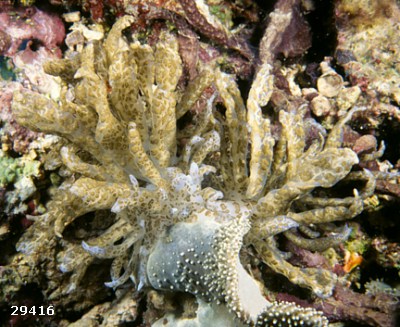
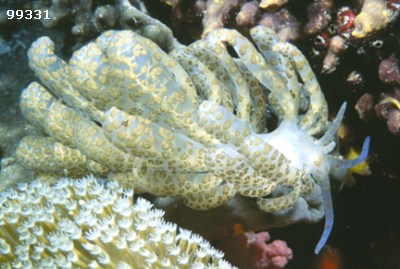
Hi Bill,
Your reply to a recent question about Phyllodesmium longicirrum prompted me to review some old pictures in my files.
Image # 29416: In February 1994 I found two P. longicirrum under a leather coral at about 20 meters on a reef east of Ambon, Indonesia. At the time I thought they were mating. However, in trying to sort out the messy entanglement of cerata I couldn't actually see that they were attached to each other.
Image # 99331: I have seen this slug several times in Papua New Guinea. This photo was shot in Milne Bay in Sept., 1993. it was crawling over the reef at about 10 meters.
After reviewing all my slides I now believe that both slugs are oriented with their heads on the leather coral. After reading in your message that they feed on the soft coral Sarcophyton, I now think this is what they were doing.
Best regards,
Mary Jane
divepng@yahoo.com
Adams, M.J., 2001 (Sep 10) Phyllodesmium longicirrum feeding. [Message in] Sea Slug Forum. Australian Museum, Sydney. Available from http://www.seaslugforum.net/find/5245Dear Mary Jane,
It certainly looks like you caught them feeding. The only published record of feeding in this animal is from Orpheus Is, Palm Id Group, Queensland (Rudman, 1991) so this is a welcome confirmation. Thanks again for hunting through your files, it is much appreciated.
I wouldn't be surprised if other divers have seen P. longicirrum feeding, but such observations only become 'knowledge' when the world is told about it them. As I have said many times before, observations by amateurs are a valuable source of knowledge for us all, so anyone out there with slide collections - please have a look for photos of animals 'doing things'. They may not be your best photos, perhaps only half the animal is in focus, but if they are identifiable and show feeding, or mating, or egg laying, or some other behaviour, they may be an extremely valuable contribution to our knowledge.
Best wishes,
Bill Rudman
Natural history of Phyllodesmium longicirrum
September 7, 2001
From: Derek Carmona
I am interested in studying the life of Phyllodesmium longicirrum and its symbiotic relationship with octocorals but I am unable to research them in there natural habitat due to the fact that I do not live in or around Indonesia or Australia. Do you know of where I can obtain specimes or if it is even possible to do so? I plan on breeding them in a tank set up as close to their natural enviroment as possible. Any suggestions on the size that would be best suitable? Do they readily breed in captivity? Also, any information on these animals would be greatly appreciated.
Thank you for your time.
Derek Carmona
carmona@maxinet.com
Carmona, D., 2001 (Sep 7) Natural history of Phyllodesmium longicirrum. [Message in] Sea Slug Forum. Australian Museum, Sydney. Available from http://www.seaslugforum.net/find/5218Dear Derek,
I am afraid it's just not possible to study the life of an animal by keeping it in captivity. Until you know something about its real life history in nature, then you won't know how to adequately prepare for it in captivity. I'm afraid we know very little about this species. What you find on the Forum and in references cited on the Forum, is about the limit of our knowledge. It is known to feed on the soft-coral Sarcophyton, but we don't know if it eats other soft corals. It obviously has a symbiotic relationship with zooxanthellae [see Solar-powered Sea Slug Page] but we can only guess that it gets the zooxanthellae from Sarcophyton. But we know nothing of its life span, whether it has planktonic larvae or any other aspect of its life cycle or way of life.
Best wishes,
Bill Rudman
Information on Phyllodesmium spp.
October 7, 1999
From: Delisse M. Ortiz
Dr. Rudman:
Hi! My name is Delisse M. Ortiz. I am a first year Marine Biology graduate student at San Francisco State University and one of Dr. Williams graduate students at California Academy of Sciences.
My research is mainly gonna be focused on predator prey interacions among the Phyllodesmium spp and the octocorals they are "feeding" on. Looking at the literature at hand...I have come across with a lot of abundant information from your research.
So far I am gathering all the data and gathering as much information as possible as to the amount of described species as well as available information with regards to the interaction among the species and phylogenetics.
I was just wondering, if there was any information with regards to a key being done for the phylogeny of the Phyllodesmium species in any of the literature that I might have not come across.
Any information will be welcomed. Look foward to your reply when possible and hope that you have a good week.
Thanks!
Sincerely,
Delisse M. Ortiz
delmar22@juno.com
Ortiz, D.M., 1999 (Oct 7) Information on Phyllodesmium spp.. [Message in] Sea Slug Forum. Australian Museum, Sydney. Available from http://www.seaslugforum.net/find/1405Dear Delisse,
Your project certainly sounds interesting. To my knowledge no one has published a phylogeny, cladistic or otherwise, of the genus. In a 1991 paper I discussed some of my ideas on the evolution of the zooxanthellae symbiosis within the genus. The possibility that adaptations for this symbiosis could have occurred a number of times, as they surely have done in other nudibranchs, makes any cladistic analysis fraught with difficulties. There are few morphological characters which appear to be independent of that symbiosis (except reproductive system).
Good luck.
Perhaps you would like to share some of your results by sending a message to the Sea Slug Forum.
Best wishes,
Bill Rudman.
Rudman, W.B. (1991) Further studies on the taxonomy and biology of the octocoral-feeding genus Phyllodesmium Ehrenberg, 1831 (Nudibranchia: Aeolidoidea). Journal of Molluscan Studies, 57(2): 167-203.
Phyllodesmium longicirrum - feeding
June 19, 1999
From: Monica Sullivan
Dear Bill,
Here is a short note on Phyllodesmium longicirrum I observed in SE Sulawesi, Indonesia, last year (Operation Wallacea ) It was monitored feasting away on the softcoral Sarcophyton sp. over a three day period - it ate a large quantity of the animal. They were found at 6 m.
Monica Sullivan
whirling@iol.ie
Sullivan, M., 1999 (Jun 19) Phyllodesmium longicirrum - feeding. [Message in] Sea Slug Forum. Australian Museum, Sydney. Available from http://www.seaslugforum.net/find/954Dear Monica,
These little notes on feeding are very interesting as it often the only way to build up a picture of the natural history of these animals. Any idea of the size of the nudibranchs. It would be interesting to know if P. longicirrum needs to 'top up' its stock of zooxanthellae with new recruits during its life time. Pteraeolidia ianthina appears to obtain a seed stock of zooxanthellae when it is a juvenile and then for the rest of its life breeds replacement plants from this initial stock.
best wishes,
Bill Rudman.
Phyllodesmium longicirra? or -cirrum?
February 16, 1999
From: Erwin Koehler
Dear Bill,
Another question: in your Malacology Gallery you have
Ph. longicirra, and in the Forum you have
Ph. longicirrum - which is the correct spelling?
Erwin
E.Koehler@deutschepost.de
Koehler, E., 1999 (Feb 16) Phyllodesmium longicirra? or -cirrum?. [Message in] Sea Slug Forum. Australian Museum, Sydney. Available from http://www.seaslugforum.net/find/570Erwin,
Thanks for picking up the anomaly. I should have changed P. longicirra a long time ago. When I put the Gallery up it was the accepted spelling, but as I was the one who changed the spelling, I can't blame anyone else! To those who are unfamiliar with such things, scientific names are governed by International Rules which, in the case of animals, are overseen by the International Commission on Zoological Nomenclature.
Part of the Rules tries to standardise the way names are "latinised" which is particularly difficult when most practising taxonomists have no knowledge of classical Greek and Latin grammar.
For those interested in the detail here is an explanation from Rudman (1991):
"Unfortunately Article 31 of the International Code of Zoological Nomenclature requires species-group names to agree in gender with the generic name with which it is presently combined. Adherence to this rule required me to alter the spelling of a number of well-known names in this genus. Phyllodesmium horridus, P. serrata, and P. cryptica, all based on Latin or
Latinised adjectives must end in -um. The name P.longicirra was more problematical. It could be treated as a noun in apposition and so stay unchanged, but Bergh apparently modified the ending from the correct 'longicirrus' to match the feminine gender of the original genus name, Myrrhine, suggesting that he was using the name as an adjective. For this reason I changed the ending to 'longicirrum'. The name of another species placed in Phyllodesmium by me for the first, P. briareus, was complicated. Bergh (1896) when naming this species gives no indication of why he used the name. However as one of the alcyonaceans it feeds on is from the genus Briareum, I assume that 'briareus' is to be treated as an adjectival form of that genus name. To agree in gender with the name Phyllodesmium (neuter) the name must also change to 'briareum.'"
You may think this has very little to do with biology - and it's a pain to sort out, but it's an attempt to keep order in the world of scientific names. Although we grumble about the problems, the International Code is one of the longest surviving international agreements - and on the whole, it works. Perhaps the fact that politicians are not involved, is the recipe for its success?
Reference:
Rudman, W.B. (1991) Further studies on the taxonomy and biology of the octocoral-feeding
genus Phyllodesmium Ehrenberg, 1831 (Nudibranchia: Aeolidoidea). Journal of Molluscan Studies, 57(2): 167-203.
